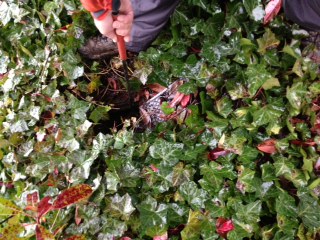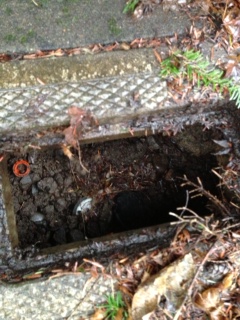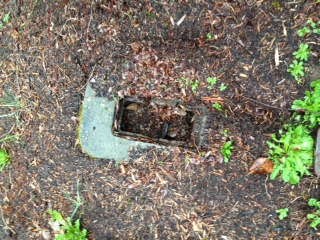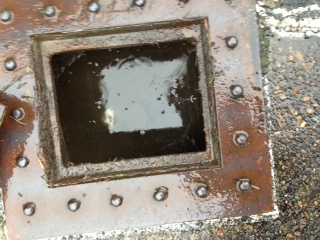CUB’s Water Meter Walkabout
Posted on April 30, 2015 by Janice Thompson
Tags, Water/Wastewater
Workers at the Portland Water Bureau read over 176,000 residential meters every three months. Daily residential routes range from 250 to 725 meters depending on housing density and terrain. The average residential route has 500 water meters and workers typically walk between 5-8 miles a day. I joined a meter reader on a rainy morning and I’m here to tell you, their work can be challenging, especially in areas without sidewalks.
The best case scenario is an accessible box with a lid that pops off readily to read the meter inside. (Photo above)
But meter boxes can be covered by plants.
Inside the box the meter can be covered with debris that must be flipped up by the reader.
Leaf debris needed to be pushed off this box and off the meter inside.
We live in Portland so meters are sometimes read through water.
These water meter reading challenges and the number of meters found all across the city are why almost all of Portland’s residential meters are read once a quarter. Monthly meter readings would either require way more workers or automated meter reading technology – both of which would increase utility costs.
Automated meter reading is under consideration in Portland, but cost estimates have been as high as $40 million. New technology options could reduce that cost, but we’d still be talking about a lot of money.
Quarterly water meter reading may seem odd given monthly reading of gas and electric meters. But gas and electric meters are typically above ground with ready access to a power source and they can be built to stay dry. Automation also doesn’t totally eliminate workers. Instead of walking from meter to meter, electrical and gas company workers drive along meter routes and pick up usage readings along the way. Those efficiencies are offset by cost of new technology and CUB has a history of making sure energy utilities carefully test automated meter reading systems and phase in new technology to ease the cost impact on ratepayers.
So there is a rationale for quarterly reading of water meters – it saves money for ratepayers. And now Portland’s residential customers can request monthly bills. Those bills are still based on a quarterly read, but split what had been a quarterly bill into three monthly payments. The amount owed is the same but monthly bills are more manageable, especially for those on fixed incomes.
The advantage of reading meters each month is that leaks or spikes in water use can be identified sooner. But does that increased information to customers justify the increased costs of automated meter reading technology? It may be that Portland has found the sweet spot with quarterly meter reads and the monthly billing option. CUB is carefully monitoring automated meter reading pilot projects in Portland and will apply our least cost/least risk approach to ensure diligent evaluation of all the options.
Please feel free to contact me with questions or other suggestions at (503) 227-1984 x24 or .(JavaScript must be enabled to view this email address).
To keep up with CUB, like us on Facebook and follow us on Twitter!








04/28/17 | 0 Comments | CUB’s Water Meter Walkabout